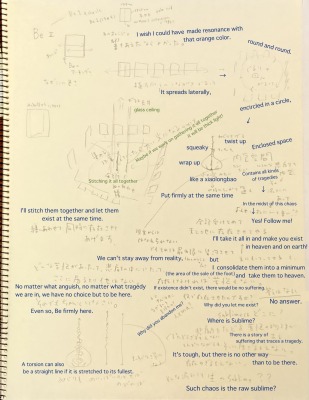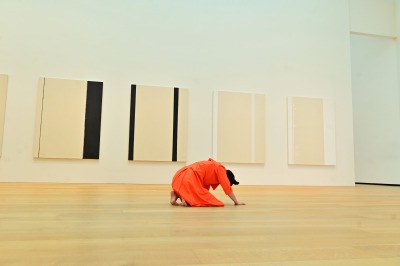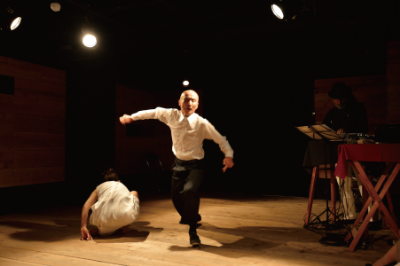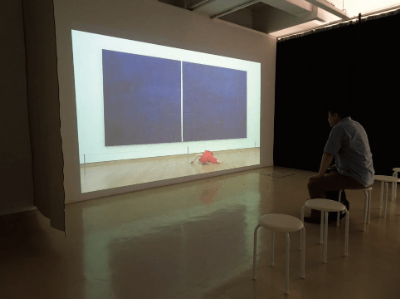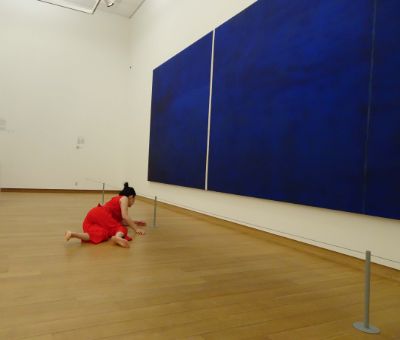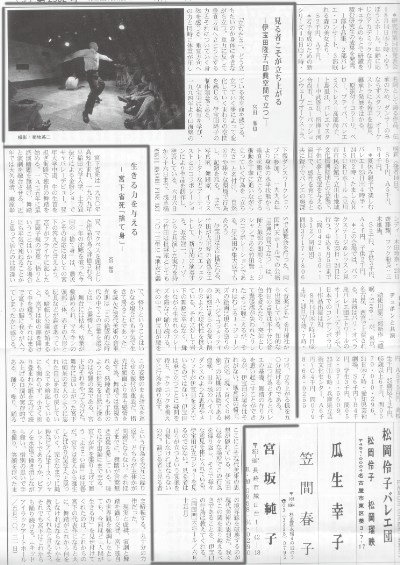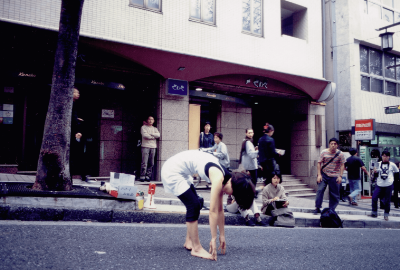REVIEW
Prayer Rituals of This Age
Keiko Imajo /SPI
For more than 20 years, I have been loosely acquainted with Ms. Ihoda's efforts as "the act of standing up while carefully following the impulse of the body to stand up from a horizontal state to a vertical state". It is a very moving experience to watch her stand up against gravity overtime on the beach, in the early morning or in the forest. Therefore, I came to the exhibition without much expectation for this indoor screening. However, I was deeply moved by the experience.
The expression on Ms. Ihoda's face as she tries to stand up in the film looks as if he is in pain, and I wonder if this is a sign of loneliness, anxiety, and a breakdown in communication brought about by the coronavirus crisis. And if the vertical lines in the paintings (which I later learned were characteristic of Newman, said to be a zip) were leading Ms. Ihoda in a vertical direction, could this act be a prayer ritual to take on the suffering of the world and sublimate it while suffering herself? And. Newman's depiction of the Passion, the present time, and this act. I was deeply moved as if I were witnessing a prayer ritual of this time period, experiencing the very "image of this space wrapped in a furoshiki and sewn up, climbing vertically" sketched by Ms. Ihoda.
The expression on Ms. Ihoda's face as she tries to stand up in the film looks as if he is in pain, and I wonder if this is a sign of loneliness, anxiety, and a breakdown in communication brought about by the coronavirus crisis. And if the vertical lines in the paintings (which I later learned were characteristic of Newman, said to be a zip) were leading Ms. Ihoda in a vertical direction, could this act be a prayer ritual to take on the suffering of the world and sublimate it while suffering herself? And. Newman's depiction of the Passion, the present time, and this act. I was deeply moved as if I were witnessing a prayer ritual of this time period, experiencing the very "image of this space wrapped in a furoshiki and sewn up, climbing vertically" sketched by Ms. Ihoda.
Keiko Imajo/SPI
Graduated from Ochanomizu University, Faculty of Letters and Education, Department of Art History in March 2000, and obtained a curatorial license.
Since April 2000, she has been working as a human resource manager at a private company and has been involved in training programs that incorporate art thinking.
* Met Ms. Ihoda in 1998 at a workshop by filmmaker Hiroyuki Ohki.
* He oversaw photography at "Tachitasa_" tours on Sado Island in 1999 and Nagano Prefecture in 2002.
* 2003-Present: Organizes the annual art event "Tamatama" hosted by Hiroyuki Ohki.
Since April 2000, she has been working as a human resource manager at a private company and has been involved in training programs that incorporate art thinking.
* Met Ms. Ihoda in 1998 at a workshop by filmmaker Hiroyuki Ohki.
* He oversaw photography at "Tachitasa_" tours on Sado Island in 1999 and Nagano Prefecture in 2002.
* 2003-Present: Organizes the annual art event "Tamatama" hosted by Hiroyuki Ohki.
from SNS posts
Katsu Takemura
“Tachitasa” Confronting Barnett Newman in Washington, D.C.
@Ningyocho Vision's
This is a rare exhibition that allows viewers to relive Performance "Tachitasa_" confronting Newman's "The Stations of The Cross" on display at the National Gallery of Art in Washington, D.C., through images projected on a huge wall surrounded on three sides as a large screen.
Takako Ihota's “Tachitasa_”.
https://tachitasa.com
The act of "standing," in which a body prostrate on a horizontal plane becomes vertical against gravity, is carefully performed over several tens of minutes.
I have previously witnessed performances on the banks of the Sumida River and in Nagatoro. At these times, the landscapes were the outside world. As a lover of city walking and natural science, one realizes that the seemingly "still" scenery of the outside world is actually a transitional stage of change. If we take the history of the earth as 4.6 billion years in one-second increments, it is always a series of "1 second / 4.6 billion years + elapsed time since 4.6 billion years + 1 second" moments. And the act of slowly and gently rising up is a universal act of human beings rising up, although it appears
to be a "movement" at first glance. This experience of "seemingly static transience" and "seemingly dynamic universality," which seems to be reversed in terms of physical sensation, was extremely interesting.
On display are Barnett Newman's series of paintings, "The Stations of The Cross" and "Be II " 15 paintings on large canvases, various vertical lines, and Takako's confrontation with the established Newman world in which Newman dominates.
First of all, Newman's work itself is intriguing. What was the process by which he arrived at each of these lines? The lines are both quiet and disturbing, so simple and yet intense that it makes us think about such things.
[Reference] Barnett Newman "The Stations of The Cross" Exhibition
https://www.art-annual.jp/news-exhibition/news/43091/
Newman emphasized the participation of the viewer in his works. This participation = appreciation is a confrontation of the vertical with the vertical, as it is performed by a human eye standing upright against a vertical line.
Takako's "Tachitasa" is an approach from the horizontal to the vertical, and she is surely the only person in the world who has participated in Newman's work from the horizontal.
And when I thought of the transition that led Newman to the verticality of his work, I spent several tens of minutes thinking that the "Tachitasa_" that is completed by standing vertically is the fundamental embodiment of Newman's work.
I strongly felt that I would like Newman himself to experience it, even though he has already passed away.
I would also like to experience Newman's series of works for myself. I want to see the real thing!
I have a weak torso and muscular strength, so I will just do the usual "vertical to vertical confrontation". LOL!
Well, I am grateful to have spent a very rich time with it.
@Ningyocho Vision's
This is a rare exhibition that allows viewers to relive Performance "Tachitasa_" confronting Newman's "The Stations of The Cross" on display at the National Gallery of Art in Washington, D.C., through images projected on a huge wall surrounded on three sides as a large screen.
Takako Ihota's “Tachitasa_”.
https://tachitasa.com
The act of "standing," in which a body prostrate on a horizontal plane becomes vertical against gravity, is carefully performed over several tens of minutes.
I have previously witnessed performances on the banks of the Sumida River and in Nagatoro. At these times, the landscapes were the outside world. As a lover of city walking and natural science, one realizes that the seemingly "still" scenery of the outside world is actually a transitional stage of change. If we take the history of the earth as 4.6 billion years in one-second increments, it is always a series of "1 second / 4.6 billion years + elapsed time since 4.6 billion years + 1 second" moments. And the act of slowly and gently rising up is a universal act of human beings rising up, although it appears
to be a "movement" at first glance. This experience of "seemingly static transience" and "seemingly dynamic universality," which seems to be reversed in terms of physical sensation, was extremely interesting.
On display are Barnett Newman's series of paintings, "The Stations of The Cross" and "Be II " 15 paintings on large canvases, various vertical lines, and Takako's confrontation with the established Newman world in which Newman dominates.
First of all, Newman's work itself is intriguing. What was the process by which he arrived at each of these lines? The lines are both quiet and disturbing, so simple and yet intense that it makes us think about such things.
[Reference] Barnett Newman "The Stations of The Cross" Exhibition
https://www.art-annual.jp/news-exhibition/news/43091/
Newman emphasized the participation of the viewer in his works. This participation = appreciation is a confrontation of the vertical with the vertical, as it is performed by a human eye standing upright against a vertical line.
Takako's "Tachitasa" is an approach from the horizontal to the vertical, and she is surely the only person in the world who has participated in Newman's work from the horizontal.
And when I thought of the transition that led Newman to the verticality of his work, I spent several tens of minutes thinking that the "Tachitasa_" that is completed by standing vertically is the fundamental embodiment of Newman's work.
I strongly felt that I would like Newman himself to experience it, even though he has already passed away.
I would also like to experience Newman's series of works for myself. I want to see the real thing!
I have a weak torso and muscular strength, so I will just do the usual "vertical to vertical confrontation". LOL!
Well, I am grateful to have spent a very rich time with it.
Recommendation Letter for Takako Ihoda and “Ta chi ta sa_2020”
Toru Iwashita (Impromptu Dancer/Dancer at Sankai Juku)
I had an opportunity to perform an improvised dance once with Takako Ihoda's “Ta chi ta sa” act. The session began with her lying down quietly right in the center of the acting area. Then Kenichi Takeda, the forerunner of improvisations, started playing the Taisho koto. I remember the act lasting for approximately 45 minutes.
I kept dancing around her during the performance. As time passed, the intensity of the centripetal force of her standing action increased. I nearly bumped into her in the end. Like a moth being drawn to a light trap.
I wonder what that force was. It might have been her perseverance to question persistently each and every process to stand up and work at it through twists and turns, rather than her pure will-power to "stand up straight," albeit very slowly.
Her “Ta chi ta sa_” performance makes us reconsider the everyday mundane action to "stand up," which has been repeated daily since we learned how to stand up in early childhood. And we realize the nobility of it!
I remembered the time when I suffered from a severe lower back pain. I attempted to stand up only to fall, and could not succeed no matter how hard I tried. It was truly frustrating! Did the mankind become literally "Homo erectus (human standing upright)" when they began to stand on two feet...?
The world of Butoh must have questioned the mankind's intrinsic nature to stand up relentlessly in the past. However, it seems as though it is now no longer being questioned. Perhaps, some people in different fields like her are following suit instead. As if to continue a discontinuous path.
Incidentally, Tatsumi Hijikata called Butoh a "corpse standing up in a desperate bid for life," and the late Kazuo Ohno said, "It is, for instance, something like a cry... made when everything becomes incomprehensible and one stands in bewilderment." However, her standing performance may be quite different from their perspectives. This is because her performance looks as innocent as a small child's first attempt to stand up.
In the “Ta chi ta sa_” performance, the goal to stand upright recedes while the process leading to it is brought to the fore. We share about sixty minutes of time with her as she tries to stand up. It is a path with many uphills and downhills, much like life itself. This is probably why we sympathize (sym = share, pathy = pain) with her all the more. Soon, her goal to stand upright is brought to the forefront and the process leading up to it recedes. When she finally accomplishes to "stand up," we sincerely rejoice together with her and deeply admire her upstanding posture.
As such, I believe Takako Ihoda's “Ta chi ta sa_” has a universality and it will also be duly accepted in America. She earnestly hopes to visit the home country of Barnett Newman, who passed away 50 years ago, and venture to perform “Ta chi ta sa _2020” in front of one of his paintings. I yearn to see this entire project unfold.
Thank you for reading this to the end.

I kept dancing around her during the performance. As time passed, the intensity of the centripetal force of her standing action increased. I nearly bumped into her in the end. Like a moth being drawn to a light trap.
I wonder what that force was. It might have been her perseverance to question persistently each and every process to stand up and work at it through twists and turns, rather than her pure will-power to "stand up straight," albeit very slowly.
Her “Ta chi ta sa_” performance makes us reconsider the everyday mundane action to "stand up," which has been repeated daily since we learned how to stand up in early childhood. And we realize the nobility of it!
I remembered the time when I suffered from a severe lower back pain. I attempted to stand up only to fall, and could not succeed no matter how hard I tried. It was truly frustrating! Did the mankind become literally "Homo erectus (human standing upright)" when they began to stand on two feet...?
The world of Butoh must have questioned the mankind's intrinsic nature to stand up relentlessly in the past. However, it seems as though it is now no longer being questioned. Perhaps, some people in different fields like her are following suit instead. As if to continue a discontinuous path.
Incidentally, Tatsumi Hijikata called Butoh a "corpse standing up in a desperate bid for life," and the late Kazuo Ohno said, "It is, for instance, something like a cry... made when everything becomes incomprehensible and one stands in bewilderment." However, her standing performance may be quite different from their perspectives. This is because her performance looks as innocent as a small child's first attempt to stand up.
In the “Ta chi ta sa_” performance, the goal to stand upright recedes while the process leading to it is brought to the fore. We share about sixty minutes of time with her as she tries to stand up. It is a path with many uphills and downhills, much like life itself. This is probably why we sympathize (sym = share, pathy = pain) with her all the more. Soon, her goal to stand upright is brought to the forefront and the process leading up to it recedes. When she finally accomplishes to "stand up," we sincerely rejoice together with her and deeply admire her upstanding posture.
As such, I believe Takako Ihoda's “Ta chi ta sa_” has a universality and it will also be duly accepted in America. She earnestly hopes to visit the home country of Barnett Newman, who passed away 50 years ago, and venture to perform “Ta chi ta sa _2020” in front of one of his paintings. I yearn to see this entire project unfold.
Thank you for reading this to the end.
Toru Iwashita (Impromptu Dancer/Dancer at Sankai Juku)

Toru Iwashita
Dancer/ International Butoh group "Sankai Juku" dancer
In solo activities, he pursued the possibility of "improvised dance as communication."
Born in 1957.
Participated in Sankai Juku from 1986.
Started solo activities in 1983. Important works, "Be all ears"- relying on Shuntaro Tanikawa's poem , "improvisational session"(with musicians and the other various artists).
Advisor/ Japan Dance Therapy Association
University Lecturer
http://www.iwashitatoru.com/
In solo activities, he pursued the possibility of "improvised dance as communication."
Born in 1957.
Participated in Sankai Juku from 1986.
Started solo activities in 1983. Important works, "Be all ears"- relying on Shuntaro Tanikawa's poem , "improvisational session"(with musicians and the other various artists).
Advisor/ Japan Dance Therapy Association
University Lecturer
http://www.iwashitatoru.com/
Contemplating Takako Ihoda's Tachitasa in 2020
Takehiko Gondo (Self-styled phenomenon artist)
I see Takako Ihoda's Tachitasa as an antagonism between gravity and will and time.
How to rise from a lying posture, when to stand up, several prioritizing conditions come to mind. Since this is an action requiring time. The observer does not focus only on the object in front of their eyes, but interprets the viewed through the title 'Tachitasa' and the significance of the location (whether in front of a picture, together with co-performers, or outside amidst vast nature). Some observers might feel tedious and their thoughts would go astray. Or they would fall asleep. All of these possibilities are correct.
Standing up is the simplest movement among movements people do. If we were to evaluate this from an evolutionary point of view, bipedalism is an important feature of human race. Even if they are not specifically taught, infants tend to stand up at some point in time. Failing their intention, they repeat it over and over. As if they were trying to tell us, so, how come you are standing, what are you trying to achieve with that. They might be thinking, I want to stand and walk like grownups do!
Seeing Takako Ihoda's 'Tachitasa' makes me wonder whether this draws near to the infant's yearning to stand up. But this might, actually, not be its aim. The 'act' of standing is inseparably connected to gravity. And finds an expression in the sheer aspiration of people, who would like to stand, but cannot. Gravity vividly shows its paws even to a perfectly healthy person in times of un-well-ness.
The real ability of 'Tachitasa' may be found when one slips through the part of being counter-gravity. This is not about infants not being able to stand up, and not about different types of situations one is unable to recover form, does a more simply 'Tachitasa' not exist?
Not recollecting with dance as an expression, just increasing the symbolism of the simple act of standing up. And not even expressing it with pure rational logic, but through joint usage of one space.
Space and time with the title 'Tachitasa' operate through the soft power focusing around a woman's movement of standing up from a lying position. Post-scripting fresh susceptibility to the terminal of audience ideas.
How to rise from a lying posture, when to stand up, several prioritizing conditions come to mind. Since this is an action requiring time. The observer does not focus only on the object in front of their eyes, but interprets the viewed through the title 'Tachitasa' and the significance of the location (whether in front of a picture, together with co-performers, or outside amidst vast nature). Some observers might feel tedious and their thoughts would go astray. Or they would fall asleep. All of these possibilities are correct.
Standing up is the simplest movement among movements people do. If we were to evaluate this from an evolutionary point of view, bipedalism is an important feature of human race. Even if they are not specifically taught, infants tend to stand up at some point in time. Failing their intention, they repeat it over and over. As if they were trying to tell us, so, how come you are standing, what are you trying to achieve with that. They might be thinking, I want to stand and walk like grownups do!
Seeing Takako Ihoda's 'Tachitasa' makes me wonder whether this draws near to the infant's yearning to stand up. But this might, actually, not be its aim. The 'act' of standing is inseparably connected to gravity. And finds an expression in the sheer aspiration of people, who would like to stand, but cannot. Gravity vividly shows its paws even to a perfectly healthy person in times of un-well-ness.
The real ability of 'Tachitasa' may be found when one slips through the part of being counter-gravity. This is not about infants not being able to stand up, and not about different types of situations one is unable to recover form, does a more simply 'Tachitasa' not exist?
Not recollecting with dance as an expression, just increasing the symbolism of the simple act of standing up. And not even expressing it with pure rational logic, but through joint usage of one space.
Space and time with the title 'Tachitasa' operate through the soft power focusing around a woman's movement of standing up from a lying position. Post-scripting fresh susceptibility to the terminal of audience ideas.
Takehiko Gondo
1964 Born in Tokyo
Self-styled phenomenon artist
Championing expressive activities regardless of social position or obtaining art education.
picture creation using black light in the presence of audience.
demo-performance and installation using a three-dimensional piece of a doll.
Self-styled phenomenon artist
Championing expressive activities regardless of social position or obtaining art education.
picture creation using black light in the presence of audience.
demo-performance and installation using a three-dimensional piece of a doll.
“Ta chi ta sa” by Takako Ihoda
Akihiro Yoshizawa
I saw a documentary video of “Ta chi ta sa” at an art gallery in Ningyo-cho, "Vision's." It was performed in front of a masterpiece by Barnett Newman, "Cathedra," which is on permanent exhibition at Stedelijk Museum Amsterdam. Starting from lying down, face up, Ms. Ihoda slowly moves her body and takes almost an hour to stand up fully.
It was half a century ago when we began calling human beings Homo Movens due to their characteristic feature for being mobile, based on the idea that mobility is what makes human valuable. Nowadays, not only tourists but also athletes, entertainers, politicians, business people, military servicepeople, and even terrorists move around the world.
To the contrary, Ms. Ihoda's performance was anything but mobile. What I saw in the video was the meaning of “Ta chi ta sa,” her pure will to be vertical, "to stand up," the title I could not understand when I first encountered it. There was no eroticism which is often seen in performances expressed by body. The way she stretched upwards, resisting the gravity, seemed like will of plants rather than that of animals.
I am probably not the only one who is surprised and moved by the way vines stretch themselves high in the air without knowing where to go. It is said that the tips of plants twist as they grow toward the sun, following a certain law of nature. The way Ms. Ihoda stood up reminded me of how such plants grow, and a long-forgotten passage from a poem by Rilke came into my mind at the same time. It was the first radiant line from "Sonnets to Orpheus."
"There rose a tree. O pure transcendence!"
At the gallery, I also saw photos of Ms. Ihoda's past “Ta chi ta sa” performances with unique structures and displays. In such performances held in front of an audience, surrounded by many eyes, she seemed to discharge excessive energy.
On the other hand, her confrontation with Newman's work "Cathedra" was performed in a space without an audience and she created a pure magnetic stage of “Ta chi ta sa” in a solemn atmosphere. I did not feel any excessive discharge of energy from the video. Just as plants generate carbohydrates through photosynthesis and grow, she seemed to generate something inside her while taking in the energy of "Cathedra." I would like to take this opportunity to see other "Newman Series" projects.
It was half a century ago when we began calling human beings Homo Movens due to their characteristic feature for being mobile, based on the idea that mobility is what makes human valuable. Nowadays, not only tourists but also athletes, entertainers, politicians, business people, military servicepeople, and even terrorists move around the world.
To the contrary, Ms. Ihoda's performance was anything but mobile. What I saw in the video was the meaning of “Ta chi ta sa,” her pure will to be vertical, "to stand up," the title I could not understand when I first encountered it. There was no eroticism which is often seen in performances expressed by body. The way she stretched upwards, resisting the gravity, seemed like will of plants rather than that of animals.
I am probably not the only one who is surprised and moved by the way vines stretch themselves high in the air without knowing where to go. It is said that the tips of plants twist as they grow toward the sun, following a certain law of nature. The way Ms. Ihoda stood up reminded me of how such plants grow, and a long-forgotten passage from a poem by Rilke came into my mind at the same time. It was the first radiant line from "Sonnets to Orpheus."
"There rose a tree. O pure transcendence!"
At the gallery, I also saw photos of Ms. Ihoda's past “Ta chi ta sa” performances with unique structures and displays. In such performances held in front of an audience, surrounded by many eyes, she seemed to discharge excessive energy.
On the other hand, her confrontation with Newman's work "Cathedra" was performed in a space without an audience and she created a pure magnetic stage of “Ta chi ta sa” in a solemn atmosphere. I did not feel any excessive discharge of energy from the video. Just as plants generate carbohydrates through photosynthesis and grow, she seemed to generate something inside her while taking in the energy of "Cathedra." I would like to take this opportunity to see other "Newman Series" projects.
July 5th, 2017 Akihiro Yoshizawa
It's the Audience Who Should Stand Up
- Stand Up in Improvising Space -
Tetsuya Miyata (Art critic)
「Ta chi ta sa」 To Stand up listening to how the body wants to stand up. To feel the inner strength and desire to stand vertically against gravity and the body which follows it. To experience the horizontal plane with the weight of the body and the impulse of the vertical direction at the same time. To feel the space around the body which would be changed while standing upright. These are Ihoda's production principles.
She Studied painting. Participated in the Toru Iwashita Dance Workshop in '94.
Carefully pursuing the urge to erect the body from horizontal position into vertical since 1995, naming this action of coming into a standing position as 'Tachitasa', reproducing it in nature and various other environments, taking records. Creating and exhibiting pieces in collaboration with artists such as photographers, dancers and illustrators. From June 6th to June 16th. Exhibition was held at MAKII MASARU FINE ARTS in Asakusabashi. The public performance at Ryogoku Monten Hall "Stand up Improvising Space" is created in collaboration with mentor and the best musical improviser Kenichi Takeda. Let us say it is a culmination of Ihoda.
Ihoda is lying on the floor. Takeda recreated the sounds of the Japanese instrument, Taisho-koto and plays it in fragments. Takeda, who excelled in joint performances with Ryuichi Sakamoto and John Zorn is also a published critic; Getsuyosha Limited published his "The Music Wriggling on the Ground" in 2013. Takeda's intelligent music changes tones insufficiently and might even appear like suddenly loosing tension, but is rather more similar to painted spots on J. Jones' pictures and it carries a kind of modernity comparable to rough shapes of A. Giacometti's sculptures as well. While on the contrary, there is no disruption to Iwamoto's dance and with continuation of dance, an expression is created universally. Amidst such surroundings, Ihoda's sitting down and standing up continues for 50 minutes.
The action of standing up may include the basics of ballet, be reminiscent of dancing, but that is not the case for Ihoda. Sho Kazakura's chair, convulsions from Taku Furusawa (originally Kubikukuri Takuzou) early era, ideas and methods of Min Tanaka's hyper dance are not the gist of Ihoda's creativity. Ihoda simply doubts in the 'act' of standing and repeats the movement without having any technique.
This is the core idea of modern art. Ihoda repeats this action in various locations, and there, she introduces different opinions into her body. This is not about seeing the show of Ihoda's standing. The observer has to internalize the awakening of standing up on his own. Breaking the boundary between the performer and the observer is the gist of modern art. Ihoda's movement teaches us the necessity of overcoming this threshold.
She Studied painting. Participated in the Toru Iwashita Dance Workshop in '94.
Carefully pursuing the urge to erect the body from horizontal position into vertical since 1995, naming this action of coming into a standing position as 'Tachitasa', reproducing it in nature and various other environments, taking records. Creating and exhibiting pieces in collaboration with artists such as photographers, dancers and illustrators. From June 6th to June 16th. Exhibition was held at MAKII MASARU FINE ARTS in Asakusabashi. The public performance at Ryogoku Monten Hall "Stand up Improvising Space" is created in collaboration with mentor and the best musical improviser Kenichi Takeda. Let us say it is a culmination of Ihoda.
Ihoda is lying on the floor. Takeda recreated the sounds of the Japanese instrument, Taisho-koto and plays it in fragments. Takeda, who excelled in joint performances with Ryuichi Sakamoto and John Zorn is also a published critic; Getsuyosha Limited published his "The Music Wriggling on the Ground" in 2013. Takeda's intelligent music changes tones insufficiently and might even appear like suddenly loosing tension, but is rather more similar to painted spots on J. Jones' pictures and it carries a kind of modernity comparable to rough shapes of A. Giacometti's sculptures as well. While on the contrary, there is no disruption to Iwamoto's dance and with continuation of dance, an expression is created universally. Amidst such surroundings, Ihoda's sitting down and standing up continues for 50 minutes.
The action of standing up may include the basics of ballet, be reminiscent of dancing, but that is not the case for Ihoda. Sho Kazakura's chair, convulsions from Taku Furusawa (originally Kubikukuri Takuzou) early era, ideas and methods of Min Tanaka's hyper dance are not the gist of Ihoda's creativity. Ihoda simply doubts in the 'act' of standing and repeats the movement without having any technique.
This is the core idea of modern art. Ihoda repeats this action in various locations, and there, she introduces different opinions into her body. This is not about seeing the show of Ihoda's standing. The observer has to internalize the awakening of standing up on his own. Breaking the boundary between the performer and the observer is the gist of modern art. Ihoda's movement teaches us the necessity of overcoming this threshold.
The Music and dance press vol.2932 Tokyo Music press corp.
Tetsuya Miyata
Art critic. Researcher in Japanese modern art theory and history: from Kakuzo Okakura, Torao Miyagawa, through Ichiro Hariu, reaches the Japanese avant-garde art after the defeat. He explores the [present] of culture by intermingling dance, butoh, music, design, video, literature, philosophy, criticism, research, and thought.
What Does 'Standing' Mean in This Point in Time
Tenko (Artist, Performer, Musician)
Standing is becoming difficult. Children are crouching down to the ground. Such times, even the adults are unable to withstand, but, no wonder. Especially in Japan, this economic superpower, people bred without realizing they were people. Despite pulling ourselves through the days cheered up on our own, no power and no freshness in the standing posture of Japanese can be found today.
The theme of Takako Ihoda's art was able to come into being because of this time and this place. It also represents one of the biggest challenges of now. The everyday action of 'standing'. But. This is the action we need to rethink anew amidst the present times.
Taking time to move that body from a horizontal position into vertical. Immeasurable interest of developing a performance centered around the most extremely simple movement buried in daily life. Physical activities occurring due to the movement of 'standing'. Of fingers, legs, arms, chest, hips, back, muscles and bones regardless of the sizes. The willpower connecting the body into erection, and the resistance, the conflict, the movements we repeat inadvertently on a daily basis, how wonderfully they complement each other. Dramatic. And lovely.
Another treasure of this performance is time. Everyone knows the stupidity in focusing on making it faster and faster. When tasting uneasiness, time fast-forwards. We cannot become strong by being quiet, by not contemplating. The drowsy passage of time created by Ms Ihoda confronts us with pondering about why we are trying to pursue speed.
The attachment to 'standing' comes into life through performance. Rather than a magnificently pretentious expression, there is hope for this reflective 'Tachitasa' in the next century.
The theme of Takako Ihoda's art was able to come into being because of this time and this place. It also represents one of the biggest challenges of now. The everyday action of 'standing'. But. This is the action we need to rethink anew amidst the present times.
Taking time to move that body from a horizontal position into vertical. Immeasurable interest of developing a performance centered around the most extremely simple movement buried in daily life. Physical activities occurring due to the movement of 'standing'. Of fingers, legs, arms, chest, hips, back, muscles and bones regardless of the sizes. The willpower connecting the body into erection, and the resistance, the conflict, the movements we repeat inadvertently on a daily basis, how wonderfully they complement each other. Dramatic. And lovely.
Another treasure of this performance is time. Everyone knows the stupidity in focusing on making it faster and faster. When tasting uneasiness, time fast-forwards. We cannot become strong by being quiet, by not contemplating. The drowsy passage of time created by Ms Ihoda confronts us with pondering about why we are trying to pursue speed.
The attachment to 'standing' comes into life through performance. Rather than a magnificently pretentious expression, there is hope for this reflective 'Tachitasa' in the next century.
Tenko
Artist, Performer, Musician
From the end of the 1970s, she started music as a vocalist of the band "Mizutama Shobodan" (Polka-Dot Fire Brigade) in the new wave scene. After starting solo activities in New York, she was invited to festivals around the world, mainly in Europe and the United States, with John Zorn and Fred Frith in the 1980s and 1990s. She established a field called "improvisational voice" that had never existed before. For seven years in the 1990s, she studied anthroposophy by Steiner through art at Emerson College in England. In addition to her performance activities, there are also workshops on voice, movement, clay modeling, etc.
http://tenko-voice.com
From the end of the 1970s, she started music as a vocalist of the band "Mizutama Shobodan" (Polka-Dot Fire Brigade) in the new wave scene. After starting solo activities in New York, she was invited to festivals around the world, mainly in Europe and the United States, with John Zorn and Fred Frith in the 1980s and 1990s. She established a field called "improvisational voice" that had never existed before. For seven years in the 1990s, she studied anthroposophy by Steiner through art at Emerson College in England. In addition to her performance activities, there are also workshops on voice, movement, clay modeling, etc.
http://tenko-voice.com
